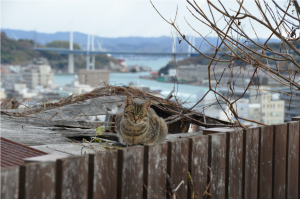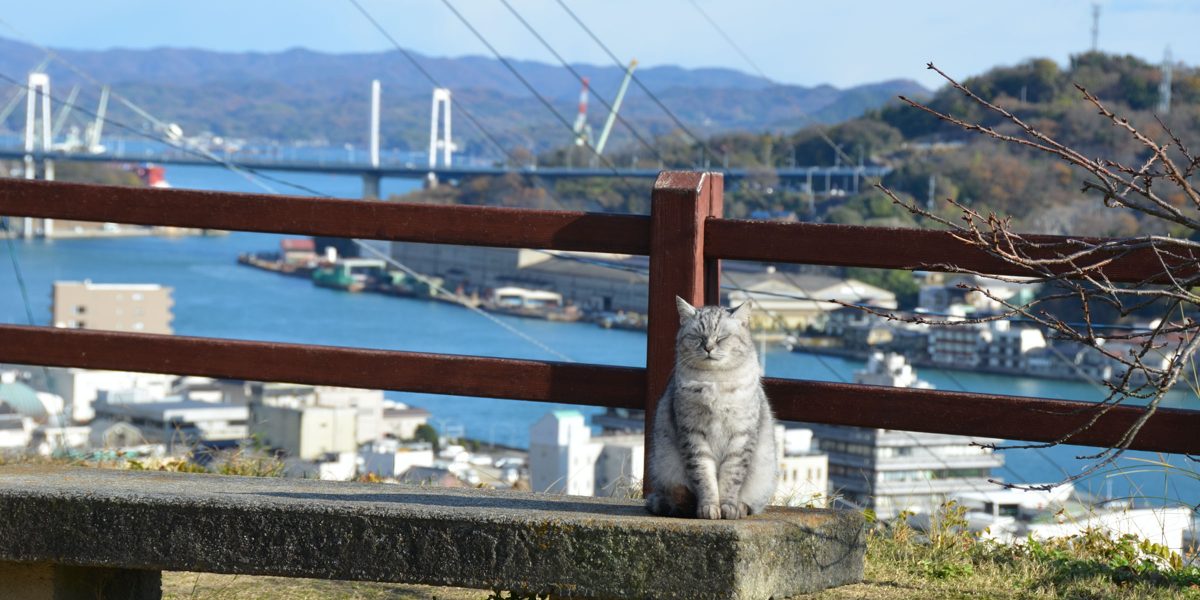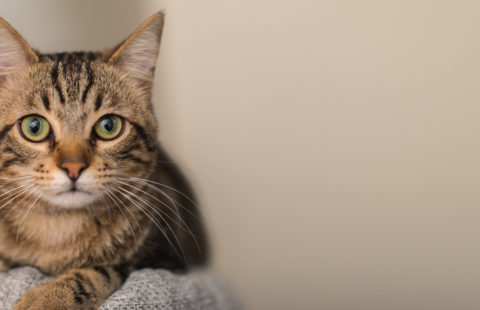At iCatCare, we recently came across a fascinating study entitled ‘The effect of a communal litter box provision on the defecation behaviour of free-roaming cats in old-town Onomichi, Japan’.
Our ‘Cat Friendly Solutions for Unowned Cats’ project is all about creating a practical and accessible resource for those working with unowned cats throughout the world, including managing feral and street cat populations, so this study really excited us to hear that researchers were interested in finding a positive and welfare-friendly solution to the problem of Japanese residents frequently encountering the faeces on paths and grass from unowned free-roaming cats living in their neighbourhood – an unsavoury problem no-one wants on their doorstep or in this case, temple! Assistant Professor Aira Seo and Professor Hajime Tanida, researchers at the Graduate School of Integrated Sciences for Life at Hiroshima University in Japan, came up with the simple idea of providing communal litter trays for the unowned cats so that the faeces could easily be contained and disposed of, keeping both the residents happy while hopefully providing an acceptable alternative toileting site for the cats too. Despite not knowing iCatCare, Assistant Professor Seo and Professor Tanida kindly accepted our invitation to share some insights from their study with us. Let’s see if those unowned cats used the litter trays.

Professor Hajime Tanida and Assistant Professor Aira Seo
Tell us a little more about yourself
Cats actually became our topic of interest because both of us have grown up with cats. Our main research interest has been the free-roaming cats in tourist area of Onomichi City. We have been researching these cats for almost 10 years. The aim of our research is to help humans and cats as well as other animals live together peacefully. We have just started the ‘community cat project’ working with the Hiroshima Prefectural Animal Management and Welfare Center.
What was the aim of the study?
We wanted to reduce the friction between residents living in the tourist area of Onomichi City caused by free-roaming cats. Some of the residents love the cats and some hate them. Defecation by the cats is one reason for such dislike, but differences in residents’ awareness of cats make the issue more complicated. Our final goal is to reduce the number of the cats by finding foster families for those that are socialized to people – many are friendly towards people due to living in a tourist area. However, we think that it is a matter of urgency to solve the problems caused by the faeces of the cats because the process of reducing the overall cat population number is relatively slow.
How much of a problem do you think faecal waste is for communities generally when considering cat colonies? Do you have any information on this?
The Ministry of the Environment in Japan reported that faecal waste of cats in communities has the largest number of the complaints. We also heard a lot of complaints from the residents in the town while doing this research.

Photo credited to Professor Hajime Tanida and Assistant Professor Aira Seo
How did you conduct your study?
The study was conducted at the temple and its attached graveyard in the tourist area of Onomichi, Japan. We identified five popular defecation sites for the free-roaming cats there. Cat faeces were collected at these sites once a week for 4 weeks. Trail cameras were set up at defecation sites to identify individual cats. After 4 weeks, cat repellent that primarily emitted the smell of acetic and isovaleric acids, was applied at the sites. The repellent is considered effective for three months and was applied once during the study. Simultaneously, six roofed cat litter boxes (each one 18.5 × 25 × 65cm), created from repurposed plastic planters and filled with commercially available cat litter, were placed at different sites with trail cameras. The faeces in the litter boxes and on the ground were collected and weighed every week for 14 weeks. In addition, we selected three sites in the town where free-roaming cats had been constantly defecating on the ground as the control sites. Faeces were collected and weighed every week for 18 weeks from these three sites.
On a practical level, did you find that the design of cover for the litter boxes kept it weatherproof?
The litter boxes had plastic roofs and in addition, we placed them under the eaves of houses and trees. Since the study, we are trying to elaborate the design of the cover so that they can blend into the landscape much better.
What influenced your choice of litter?
We chose litter which was a popular brand and a low price. We think that local cat feeders and cat care takers who want to use our idea to control faeces of free-roaming cats can afford to purchase this brand. In our case, it was a clumping wood-based litter.
What were your main findings?
The provision of communal litter boxes and the application of cat repellent in the territory of unowned free-roaming cats is effective in changing their defecation behaviour in a manner that reduces the amount of faeces found freely in the area. Of the 17 cats recorded on the trail cameras in the area, three were responsible for the defecating on the site covered by the trail cameras. Within the first week of the provision of the litter boxes, all three cats started to use them and continued to frequently use them over the course of the study with the exception of when the weather was bad. During this time, they rarely used them. We think this is because, during heavy rain, the cats seek cover and do not want to travel in the rain to the litter boxes – they do not like getting wet!

Photo credited to Professor Hajime Tanida and Assistant Professor Aira Seo
How amenable did you find the cat feeders to the idea of cleaning and maintaining litter boxes?
They looked with favour at our proposal. In addition, municipal administration is also interested in placing the communal litter boxes in the town.
How was the litter disposed of?
The temple staff took over the process of cleaning and maintaining litter boxes. They understood our methods and kept cleaning litter boxes since then. The litter was either incinerated in the temple or taken out as garbage.
Was there anything that surprised you?
The fact that the cats shared the communal litter boxes, although they do have preferences over which boxes they prefer. We did not expect that. Our assumption is that they tend to choose the box that is located in their territory.

Photo credited to Professor Hajime Tanida and Assistant Professor Aira Seo
What would be your top tips from the results of your study and who would they be for?
Our final goal is to reduce the number of the cats who do not have an owner and would benefit from one from the point of cat welfare. There are two types of stray cats in the old town of Onomichi City. One type is the abandoned cats who used to be house cats. The other type is the cats whose parents are also stray cats. The former cats are well socialized. We think that giving these cats an affectionate owner makes for much happier cats (and people). The cats that are not socialized prefer to live outdoors so a different strategy is needed for them. We hope that providing the communal litter boxes is a temporary way of reducing the faeces.
Where do you hope the results of this study take you next?
As mentioned above, we plan to conduct research to find ways of reducing the number of unowned free-roaming cats.
Any plans to expand on this piece of research to look at educational campaigns to work alongside litter box provision to manage faecal waste?
We plan to have educational campaigns in collaboration with the Hiroshima Prefectural Animal Management and Welfare Center. Each prefecture (47 prefectures in total) has a few centres to manage stray dogs and stray cats. This particular centre tries to rehome dogs and cats who are friendly with people. In addition, the center supports ‘communal cat activity (TNR)’ by performing spaying and neutering for free. They also offer animal welfare classes at schools and kindergartens on request.
It’s clear your research tackles issues with the aim of improving the relationship between unowned cats and people but do cats feature anywhere else in your life?
We both are cat lovers and we live with cats who used to be unowned cats.
Had you heard about iCatCare before Sarah contacted you? If so, what are your thoughts on us as a charity? If not, we would love to hear your initial thoughts?
We never heard about iCatCare. We think that information and news in the website are very useful for cat owners and caretakers. It’s a great honour to have our study featured.
So, there we have it – providing communal litter trays for these unowned free-roaming cats helped manage the problem of undesirable faeces (and their associated air pollution) upsetting local residents in the temple area where the litter boxes were placed. Interestingly, it was only three cats causing most of the defecating in this particular area(the others choosing to defecate outside the study area). Thus, six large litter trays provided the cats choice. Assistant Professor Seo and Professor Tanida point out that when considering such an intervention for cat faecal pollution, consideration must be given to the optimum number of litter trays and the necessary frequency of litter box cleaning, which of course requires committed volunteers. Furthermore, they suggest greater efficacy when combined with an educational campaign. At iCatCare, we we appreciate that the most sustainable and effective way to manage street cat populations is to engage with the local community, not only working with people who see cats as a positive addition to their lives but also those who see them as a nuisance. Assistant Professor Seo and Professor Tanida have illustrated how important it is to get the whole community on board and this often involves offering practical solutions for problems associated with living alongside cats in this way.
A huge thank you to Assistant Professor Seo and Professor Tanida for taking the time to give us insight into their research. We really look forward to following your work and learning more about your next research projects on unowned cats.
Want to learn more?
Learn more about unowned cats and in particular, the needs of different cats, here
And follow the link to understand more specifically about feral, street and community cats
Reference for the study
Seo, A., & Tanida, H. (2020). The effect of communal litter box provision on the defecation behavior of free-roaming cats in old-town Onomichi, Japan. Applied Animal Behaviour Science, 104938.






